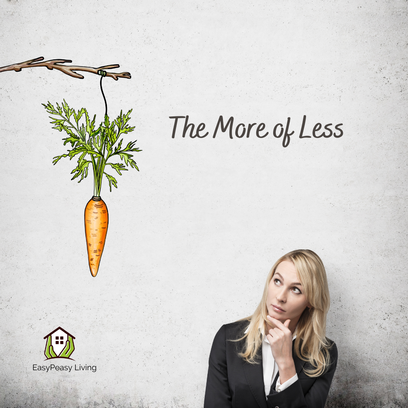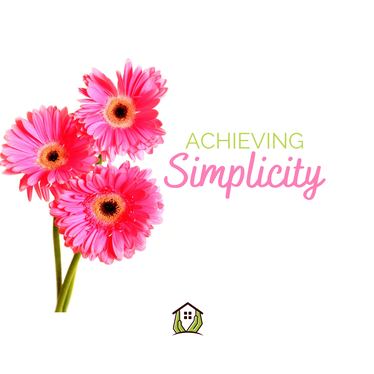 Living life seems to require a lot of stuff. We need stuff to wear...stuff to cook and cook with...stuff to sit, sleep, eat, and work on...stuff to entertain us and stuff to help us entertain others...stuff to help us work more efficiently...stuff to read, write and communicate with...stuff to decorate and create with...stuff to keep us safe and healthy...stuff to make us more comfortable...stuff to keep us smelling, looking and feeling our best...stuff to help us relax...stuff to give each other and stuff to wrap it up in...stuff to keep us warm and stuff to keep us cool...stuff to fix and clean all our other stuff with...and stuff to keep all this stuff organized and accessible when we need it. And every single piece of stuff we own comes with a price tag...not just a financial price tag but also a time, space, effort, convenience and opportunity price tag. Reducing the amount of stuff you own also reduces your overhead costs. Minimalism is about getting by with less stuff so that you can focus more on all those other things that really matter in life. But you don't have to be a minimalist to benefit from making do with less. July is Organizing for Dollars Month, so today I’m going to share a few strategies for shrinking your pile of stuff to save you money...plus a whole lot more. One reason we get so overwhelmed by all of our stuff is that most of us own waaaaayyyyy more than we need or have room to accommodate. We go through phases where we get so fed up we decide to weed out our closets and donate our excess...and it feels pretty great for a while. But eventually, we end up right back where we started, because we never changed our thinking about what we really need versus what we just want. To change your mindset, you must begin challenging yourself to stop acquiring something new to fulfill every new need that arises. With a little resourcefulness and creativity, you can meet most of your needs by shopping in your own closet. If you don’t believe me, why not try imposing a moratorium on new purchases for one whole week and see for yourself how well some of these seven strategies can work: 1. Use up what you have first before replenishing How many skincare samples, hotel shampoo bottles, and still-in-good-shape gift bags are you hoarding? For what? Start using them. Get them out of your way before you buy more of the same. Plan meals around the food that’s been in the back of your pantry or freezer and needs to get eaten. (Read this great article on the myths of food expiration labels before you pitch it.) Use items in your craft supply stash or some of those leftover DIY materials in the garage to create something you need rather than pulling out your wallet to buy it. You’ll be amazed how much money and space you’ll save just by using up the various odd bits and pieces that are currently filling up your cabinets and drawers. 2. Review your stashed decorative items Are your closets and storage areas filled with framed photos or artwork you took down but may want to use again...someday? What about all those cute tchotchkes you’ve been saving in some bin somewhere because they have sentimental value but no good spot to call home? Review these with a critical eye and make some decisions. Perhaps some can be made into functional objects or to freshen up your current decor. Others may make wonderful gifts. If you’ve been meaning to hang it up, then do it now! You’ll free up valuable storage space and fulfill a need without spending a cent. 3. Gift/regift new items you know you’ll never use. Rather than spend valuable space on something you don’t need/want, give it to someone who would. You’ll save time and money on gift shopping, not to mention space! 4. Gift wrap creatively Instead of buying special occasion-specific wrapping paper, you’ll get more mileage out of it if you use neutral gift wrap suitable for any occasion and embellish it with items from your garden or leftover craft supplies. Reuse gift bags that are still in good condition or re-purpose all manner of materials as creative wrapping. An old sweater you’ll never wear plus a needle and thread and some ribbon are all you need to make a one-of-a-kind gift bag for Christmas. 5. Furnish your home with “double-duty” pieces Look for opportunities to double up on the functionality of your high ticket items, like furniture. Some examples are using a storage trunk or ottoman for a coffee table; turning a narrow cubby-style bookshelf on its side and adding a seat cushion to the top to create seating with book or toy storage; mounting a small ironing board to the top of a rolling storage cart. Look for end tables with drawers, console tables with shelves underneath, and desks with built-in filing drawers. 6. Rely on multi-taskers when entertaining Instead of overstocking your kitchen and dining room with specific serving pieces and party supplies, try some of these substitutions using what you already have on hand:
7. Give your kids experiences as gifts Let’s face it: raising kids is expensive, especially if you want them to experience life to its fullest. Instead of spending money on tangible gifts you’ll just need to find space for, use it to splurge on a fun trip or activity you may not otherwise be able to afford to celebrate a special occasion or holiday. One bonus is that these gifts are a lot easier to wrap too! Obviously, the more organized your home is, the easier it will be to fulfill a new need with an old purchase, because you’ll have a better handle on what you already own and know where to find it. And the less you own, the easier it is to keep everything organized and accessible. If you’re drowning in belongings, the first step is to turn off the tap and stop acquiring! Once you get used to looking for a solution in your own closet instead of a store, it will become a habit. In case you missed it, this month’s EasyPeasy 1-Day Challenge is to substitute something you already own for something you were planning to buy. To enter the monthly gift card drawing all you have to do is visit my Facebook page by July 31 and comment on the July 1-Day Challenge post at the top of the page telling us 1) What you were planning to buy and 2) What you found in your own home to fulfill the need instead. You must include both parts to be entered into the prize drawing. I can’t wait to see how clever and resourceful you all are!
2 Comments
 What’s in it for me? C’mon, admit it. Most of the everyday responsible actions you take...from getting out of your warm, cozy bed on a cold morning to going to the dentist or getting a flu shot are because there’s something in it for you. You get to keep your job, keep your teeth, and keep from getting sick, to name a few. I mean, how many people do you think would actually pay their taxes just because it’s the right thing to do if they didn’t also see keeping their freedom as a pretty major benefit? It’s human nature to want something in return for your inconvenience and sacrifice. Even kids understand this concept from a young age, as evidenced by my son who once offered to pull out all of his teeth for the tooth fairy if she’d just bring him enough money to buy a Lego death star. (Little did he know that, with a little patience, she’d end up with all of them eventually anyway.) We parents teach our kids this notion of hardship eventually leading to a payoff when we incentivize them to behave, to do their chores and their homework, and to sacrifice for others. Be it sticker charts, extra privileges, or even just heaping on the praise, we are reinforcing this idea that doing the right thing, even when it’s hard, yields positive dividends. Even when we want to improve our own behavior, we promise ourselves little rewards for rising to the challenge. And there’s nothing wrong with that, just as long as we select a prize that won’t end up sabotaging our efforts. (A new outfit for your slimmed-down body is probably a better reward for sticking to your diet than a celebratory cake...just sayin’.) But incentives only work when we consciously identify what they are and specify the actions required to earn them. Case in point: I figured out a long time ago that a tidy, uncluttered environment keeps me calm and reduces my stress level more than just about anything else. I have two teenagers, so it’s a given that I’m going to feel stress in my life. But I know that the visual peace of a neat home and knowing exactly where to find everything will allow me to better manage all the anxiety that naturally accompanies the thought of paying for college, not to mention my babies driving and dating. That’s a reward that is well worth spending an extra minute here and there to put things away...even things that were left out by others. It’s the thing that motivates me to regularly clean out my closets and get rid of all the excess stuff I don’t really need. Just knowing that I will have sufficient room to house and conveniently access my well-thought-out purchases is all the enticement I need to avoid making impulse buys I might struggle to put away when I get it home. That effort is a gift I give myself because I’ve already determined that the payoff is huge. I don’t keep my home organized for the benefit of guests or my family. It’s for me. Which is good, because these days I rarely entertain, and my family couldn’t care less how tidy and organized everything is as long as they can find their remotes and locate the router when the wifi needs resetting. So what’s in it for you to have less stuff? What do you get out of purging your excess...passing up a great sale...forgoing freebies and hand-me-downs...giving away some of those sentimental objects you have stored away but will likely never use? Might some of these benefits of streamlining help you pare down?
Take some time to think about your top ten motivators for cutting back your belongings and write them down. Then dangle that carrot where you can see it clearly. Review it regularly to remind yourself what’s in it for you to tidy up before bed, to find a home for everything you own, to stop acquiring, or to donate or recycle all the stuff you can do without. With a little awareness and the right incentive, even discovering the more of less will be easy peasy. Don't miss out! Sign up to have each new EPL Blog post delivered to your inbox each week.
 , thenHave you ever noticed how time-consuming consuming food can be? First we have to decide what food to eat. Then we have to acquire the food. Next, we have to prepare the food. After that, we actually eat the food. And finally, we must clean up from preparing and eating the food. And this cycle never ends. Most of us perform each of these tasks several times, every single day. It stands to reason, then, that any effort to simplify our lives must include simplifying how we consume food. Whether you are cooking for a large family or eating alone, a little planning can go a long way toward saving valuable time, effort, money and energy in the kitchen. Knowing in advance what's on the menu will allow you to take advantage of some shortcuts and ultimately leave you feeling less stressed and more satisfied by your meals. As you may have gathered, I'm a big advocate of meal planning and have created this free guide and menu planner to help teach you just how easy peasy it can be. But whether you plan a week's worth of dinners in advance or not, here are my top 20 tips for simplifying cooking and eating:
The most important rule of all to follow when it comes to cooking and eating your food is to simply enjoy the moment! Take a much-needed break from your daily stresses as you eat. If you're eating with others, enjoy the time together and some good conversation. If you're eating alone, enjoy the quiet solitude and time to reflect. Either way, put your phone down, turn off the TV, and give yourself some time to unwind. Eating should be about replenishing your mind and soul, as well as your body. Be present in the moment. You invested a lot of time and effort in creating it...make it worth it! With a few tips and a healthy appetite, even keeping food simple can be easy peasy. Don't miss out! Sign up to receive new posts of the EPL Blog, delivered right to your email each week.
 Today's adults are busier than ever…we are kids' chauffeurs, homework helpers, community volunteers, short order cooks, corporate slaves and marathon commuters. The demands on our time are never-ending. In a world of instant access, we keep trying to cram more and more into the same 24 hours. Then, we fill our homes with stuff we think will make life “easier”...time-saving gadgets in the kitchen, clever electronic devices in our pockets, anti-stress and anxiety medications in our cabinets. Our constant need to “keep up” with our friends and neighbors lures us into an endless quest for the latest fashions in clothing and decor, the newest video games, the best new this, that or the other. Before we know it, our cluttered homes, hectic schedules, stretched budgets, and frazzled nerves seem to conspire against us to withhold from us the one thing that most of us crave: simplicity. Simplicity is the removal of the unnecessary to make room for peace and clarity. Less stuff, fewer commitments, efficient routines, clearer priorities all both lead to and result from simplicity. So how do we achieve simplicity? It all begins with greater self-awareness. You cannot remove the unnecessary from your life until you identify what is truly necessary. To do that, answer these questions: What are your priorities? What most fulfills your sense of purpose? What brings you joy? What activities do you truly need to have in your life to feel whole? If you want to live the simple life, you must build your life around these priorities, not the other way around. Do your career choices, hobbies and volunteer activities reflect your priorities, or arrived at the road you are on simply because it was the path of least resistance? Very often, what feels like the easier path at the beginning turns out to be the more difficult one in the long run. But do not confuse simplicity with ease. Achieving simplicity usually requires change, and change is rarely easy. What are your strengths? Identifying your strengths enables you to play to them. It also highlights what are not your strengths. Find people with different strengths from your own to help you with your weaknesses. Life becomes simpler when we accept these realities and include them in the planning process. And when we cannot avoid performing tasks that are not among our strengths, modifying our expectations of ourselves...giving ourselves the patience and grace to be less than perfect...gives us the courage to try. What is your plan for getting where you want to go? Be patient enough to plan. There are no shortcuts. Everything worthwhile takes effort, even simplifying. It’s where you invest your effort that makes the difference. Invest it in making a plan and then executing that plan. If you plan carefully and patiently, knowing your limitations and playing to your strengths while giving yourself the grace to stumble, fall and learn, follow-through becomes much simpler and more straight-forward. What do you really need that you don’t already have to achieve your goals? You may be surprised at the answer to this question. It is likely not to be more physical belongings. Time. Space. Money. Energy. Confidence. Understanding. Moral support. Knowledge...none of these needs will be met by an Amazon delivery or trip to the store. If you truly want to simplify your life, remove those non-necessities. What do you already have that you do not really need? Remove the unnecessary to make room for more peace and clarity. Make room in your home for more living. Make room in your head for more thinking and dreaming. Make room in your heart for more caring. Make room in your calendar for more planning. Our lives are cluttered with extra steps because we don’t plan properly or are trying to be too perfect; with extra commitments because we don’t acknowledge our limitations; with extra effort because we are so rushed we mess up, having to do it all over again; with extra stuff because we haven’t taken the time to figure out what we actually need, versus what we want; and with extra stress and anxiety because we don’t know who we are or how to achieve simplicity. But we can change all that. With a little planning, self-awareness and some resulting simplicity, even the most cluttered, frazzled life can become easy peasy.  Blank space promotes visual peace Blank space promotes visual peace Space truly is the final frontier! Everyone seems to be on an endless quest for it...for space in their homes...on their desks...in their busy lives! Yet it eludes most of us. Just as soon as we find some....poof! It’s gone and the search begins anew. But what if instead of spending all of our space, we kept some of it….empty?!! Today, I’m making a case for space! First, how is empty space even useful?
Preserving your empty space boils down to choosing space over stuff. You may be asking...if empty space is so valuable, then why do people tend to choose stuff over space? Good question! Clients usually call me when their lack of space begins causing a problem in their lives. They are aware that they need more space, yet still seem compelled to fill it back up again when given the opportunity. Why? Here are some of the most common reasons, along with my counterpoint for each one: Do any of these sound familiar? Fear of being without something you may need (clothes, paper towels, shoes, serving dishes). Counterpoint: If you run out of something, you can go shopping, do laundry, borrow from a neighbor, order online. If none of these are possible, you will likely find a way to make do in an emergency. Such emergencies will be very rare and far outweighed by the everyday benefits of having more space. Think up a back-up plan in advance if that makes you feel less afraid to part with something. (Personal aside: At the beginning of the COVID-19 crisis when toilet paper was difficult to find, I came up with multiple contingency plans for if/when we ran out. I never had to use any of them, but now that I have them, I don’t feel a need to use up my valuable space hoarding toilet paper.) Avoiding a deep-seated (and usually misplaced) perception of poverty and/or a misperception of “wealth”. Counterpoint: Having more stuff doesn’t make you rich. It actually costs you more in the long run. Would you rather be “rich” in stuff that gets in your way, or rich in time and energy that can be spent on having new and meaningful experiences, learning more about the world, and forging/maintaining important relationships? Which will matter more at the end of your life? Remember, that old adage “You can’t take it with you” refers to your material wealth, aka your "stuff". Unwillingness to make choices (aka decision deferral). Counterpoint: Making decisions gets easier and quicker with practice and takes less time when you do it on a daily basis. Developing a habit of making decisions in the moment takes effort but will pay huge dividends in the long run. Need to fill up the other aspects of life that feel empty (relationships, self-esteem, productivity, sense of control). Counterpoint: Space gives us freedom. We need space to live in, move in, fill up with the people and activities that bring us joy. When we do that, we will not feel emptiness; we will feel fulfilled. So how do we create and maintain empty space? Simple: Choose space over stuff. Now that you understand the value of empty space and why you may have chosen stuff instead in the past, it will be easier to make more intentional decisions in the future. There are three key components to this:
With a little conscious decision-making and a few good habits, even holding onto empty space can be easy peasy! You'd think her stint in the big house might have put the domestic goddess back in touch with mere mortals like us, but a quick perusal of organizing tips on her website indicates otherwise. So I've taken the liberty of modifying some of her ideas to appeal to people like me who have limited time, money, and--to put it bluntly--patience for her hoity-toity bullcrap.
Martha says: Make a handy canvas tote with lots of pockets by sewing a carpenter's nail apron... (she lost me at "sewing") EasyPeasyLiving says: Buy a gardening tote. They have lots of pockets and often come in cute patterns. Martha says: Create cute little calendar labels for your freezer bags out of my adorable clip-art files that will use up most of the ink in your printer cartridge. This way you will know by when you must consume the contents. EasyPeasyLiving says: Write the date by when you should consume the contents right on the bag with a sharpie. Martha says: Laminate a "To Do Before I Go On Vacation" list on card stock, punch with eyelet puncher and attach with decorative ribbon to your luggage so you don't forget to do anything before you go away. Laminating means you can re-use the card next time you go on vacation. EasyPeasyLiving says: Tape your handwritten "To Do" list to the front door so that you see it before you walk out the door instead of when you are checking your luggage at the airport. By the next time you are lucky enough to get away, you are sure to have a completely different set of tasks to do before you go. Martha says: Spend a little time creating stylish organizing tools that you can show off to all your friends. All those superficial little details will let them know you care about impressing them. It's a good thing. EasyPeasyLiving says: Spend the time and mental energy you save by being more organized on enjoying and laughing with your friends. It lets them know you care about them. It's the real thing. |
AuthorValerie Sheridan is a professional organizer, wife, mother of two, and Founder/Owner of EasyPeasy Living. Archives
October 2022
Categories
All
|

 RSS Feed
RSS Feed